Bogdan Raczkowski
Bogdan Feliks Raczkowski (1888-1939) was an influential engineer, builder and urbanist in Bydgoszcz, from the 1920s till the outbreak of WWII.
Bogdan Feliks Raczkowski | |
|---|---|
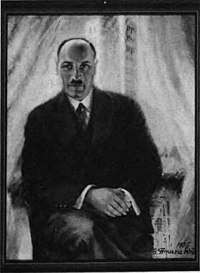 Raczkowski c. 1935 | |
| Born | March 12, 1888 |
| Died | October 4, 1939 (aged 51) Bydgoszcz, Poland |
| Nationality | Polish |
| Occupation | Architect, engineer |
| Spouse(s) | Maria Raczkowski née Zawadzkie (1895-1939) |
| Children | Danuta Walentyna, Zdzisław |
| Parent(s) | Walentyna Raczkowski née Dąbrowska and Feliks Raczkowski |
Personal life
Early life
Bogdan was born in Poznań on March 12, 1888 from Feliks and Walentyna née Dabrowska.[1] He graduated from the Saint Mary Magdalene High School in Poznań (Polish: Liceum Ogólnokształcące św. Marii Magdaleny), like his older brother Tadeusz Jan who later became an agronomist and head of the School of the Chamber of Agriculture in Bydgoszcz.[2]
He then carried on his studies at the faculty of architecture of Lviv university. There, he rubbed shoulders with students, some of whom outstanding engineers or architects:
- Jan Sas Zubrzycki (1860-1935)
- (in Polish) Witold Minkiewicz (1880-1961);
- (in Polish) Jan Bagieński (1883-1967);
- (in Polish) Tadeusz Obmiński (1874-1932).
Shortly before the outbreak of First World War, Bogdan Raczkowski, as a young graduated engineer, moved to Kharkiv to handle the construction of his first project. There, he met and married on August 24, 1917, Maria Zawadzkie, born on February 23, 1895, the daughter of a railway official. As a result of the Russian October Revolution the same year, the couple fled Russia by boat across the Black Sea and got back home to Poznań after a journey through Romania, Hungary and Czechoslovakia.[3] In Poznań, their daughter Danuta Walentyna was born on May 23, 1920.
Life in Bydgoszcz
The family settled in Bydgoszcz in spring 1921 at 3, Stanisław Moniuszko street.[1] On December 29, 1921, he became a city councilor and chaired the Office of Ground Construction. After a dispute at the municipal council, Bogdan Raczkowski was dismissed these positions in April 1934: he then became an appraiser at the Bydgoszcz branch of Bank Gospodarstwa Krajowego. On her side, Maria was active in Bydgoszcz branch of the Polish White Cross, the social movement created in February 1918 by Helena Paderewska, second wife of Ignacy Jan Paderewski.[4]
Fleeing the Nazi invasion, the Raczkowski's left Bydgoszcz and moved to Marie's family estate in Kutno in September for one month. When they came back, their house at 1, Asnyka street was occupied by a German officer: hence they moved to live at a cousin's flat, Stefan Jeżowski, on Weyssenhoff Square. Nazi authorities arranged for them to pick up few of their belonging from their former house on October 2, in the afternoon: when Bogdan and his daughter went to collect their belongings, they found the villa surrounded by the Gestapo. Both of them, together with Maria were arrested and shot on October 4, 1939, in the forest, north of Bydgoszcz (Polish: Las Gdański). Only their son Zdzisław escaped the round up, as he stayed with friends at that time. He quickly left Bydgoszcz and hid for the entire period of the war under the name of Zbigniew Koźmian.[1] To make matter worse, Tadeusz, Bogdan's brother, was executed at the Valley of Death in late October 1939.
Bogdan Raczkowski also painted pictures: landscapes of places he visited (Zakopane, Ciechocinek, Hel, Orłowo, Kharkiv, Rostov, Sevastopol, Capri, Rome). From 1931 onward, he had been a board member of the Society of Friends of Fine Arts in Bydgoszcz.
Professional career
In 1921, Bogdan supported an urban development plan in the area delimited by streets Mościcki (now Sportowa), Chopina and Moniuszki. His family lived in one of the houses of the project, located at 3 Moniuszki street.[5]

More broadly, Bogdan Raczkowski carried on the urbanization of Sielanka (English: Idyll) district,[6] initiated before the first World War. In the 1920s, 50 plots for building were defined with stringent building guidances regarding the height and width of the houses, number of their rooms, even the type of fence. The 50 houses were built by the end of the 1930s.[7] At the same time, Raczkowski prepared an expansion project to give an area further north (Skrzetusko) an homogeneous character (sector defined by streets Płocka, Chodkiewicza, Sułkowskiego and Kozietulskiego). First realizations include today's houses at 5/7/11 Płocka street.
1926-1936 Bydgoszcz development program[3]
Bogdan Raczkowski devised a grand urbanization project for the city, intending to support private construction initiatives and identifying specific areas to be developed. In addition to Sielanka and Skrzetusko districts, he focused his attention to streets Czarna Droga, Dwernickiego, Libelta, Niemcewicza and Piotrowskiego.

His idea was to assign districts purposes:
- residential for Bielawy, Skrzetusko, Szwederowo, Bielice, Wilczak and Okole;
- worker's dwellings for Miedzyń and Jachcice;
- factories at Kapuściska, Zimne Wody, Łęgnowo, Siernieczek.
The last chapter of this extensive project was aiming at planning the urbanization of Leśny district, so as to become a showcase of Bydgoszcz for people entering the city from the north. With that ambition, in October 1933, the architect divided the 30 hectares (300,000 m2) area into 9 plots. This project was completed only on the eastern side of Gdańska Street, as the Ministry of Military Affairs did not allowed the development on the western part.
Works in Bydgoszcz
Bogdan Raczkowski's education at the faculty of Lviv gave him the taste for new trends in architecture. At a time when neoclassicism was declining, technical and industrial progress opened up building potentials, with state-of-the-art materials (steel and glass) and innovative methods. In addition to the following realizations, Raczkowski also conceived habitations at Babia Wieś (1926-1927), at 22-38 Żwirki i Wigury street (1930) and prepared in the early 1920s a project -never carried out- for the basilica of St. Vincent de Paul in Bydgoszcz.
Building at 13 Piotrowskiego, 1923-1925
This tenement displays classical shapes on a 4-storey façade, topped by rosettes.
 Tenement at 13, Piotrowskiego
Tenement at 13, Piotrowskiego
Saint Stanislaus Church in Bydgoszcz, 1923-1925
The Saint Stanislaus Church in Bydgoszcz was registered on Kuyavian-Pomeranian Voivodeship Heritage List (No.601224, A/858/1-2) June 28, 1995[8] Located at 1, Kaplicznej street, the church is dedicated to Stanislaus of Szczepanów. The City Council donated the plot where a former police station stood: works of demolition of the latter started in June 1923.
The funds for the construction were gathered by Bydgoszcz citizens. The church steeple was completed on May 18, 1924, and the formal consecration took place on May 21, 1925. The design refers to Polish wooden churches. The stained glasses in the chancel dating back to the inception of the church (1924) have been funded by Bydgoszcz mayor Bernard Śliwiński and city councillor Arthur Franke.[9]
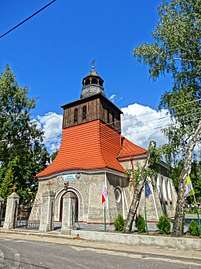 View of the church from the street
View of the church from the street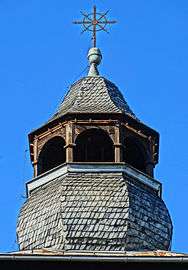 Detail of the steeple
Detail of the steeple Chancel and stained glasses
Chancel and stained glasses
Building at 45 Grudziądzka street, 1927
The edifice has been designed to accommodate old people,[10] augmenting the capacity of an existing facility at 1 Szubińska street. The previous and outdated house was put into service on December 9, 1885, as an element of one of the first hospital ensemble in Bydgoszcz funded by a donation of Ludwika Giese-Rafalska, the owner of an estate in the south-east of the city.[11]
Raczkowski's edifice could host 80 residents in a variety of rooms and included a chapel, a large dining-room, a terraced garden and attic rooms for servants or workshops. The building was inaugurated on July 29, 1928, by the President of the Republic of Poland, Ignacy Mościcki. Nowadays, the building houses the fifth Department of the District Court of Bydgoszcz, in charge of Family and juveniles affairs. It has been renovated in late 2017.[12]
 Article relating the building in 1927
Article relating the building in 1927 View from Grudziądzka street
View from Grudziądzka street Side view from the parking lot
Side view from the parking lot
Polonia Bydgoszcz Stadium, 1924-1929
Raczkowski designed the Polonia Bydgoszcz Stadium, unveiled on August 3, 1924.[13] Conceived as an athletics facility, the architect also supervised the following additions: a football pitch (1926), a cycling track (1927), reinforced concrete 200-seat grandstand (April 1928) and athletics equipment with 6 training pitches (1929).[14] Today, it is used mostly for speedway fixtures. It is home stadium of Polonia Bydgoszcz sport club.
 Global view
Global view
Tenement at 2 Weyssenhoffa square, 1927
The 2 Weyssenhoffa square was realized as an element of the Sielanka housing estate project. Located on the south-west side of the square, its shape sticks to the gentle arc of the bordering avenue (Ossoliński Alley in Bydgoszcz). It boasts a mix of functionalist style (left side) and eclectic forms (right side) with a loggia and Mansard roof, so as to mirror the adjacent front facade of the eclectic building with Art Nouveau decoration (erected in 1906-1908).
 General view of frontages
General view of frontages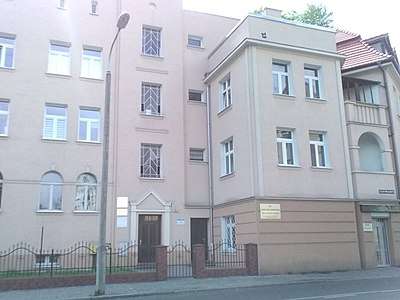 Functionalist facade
Functionalist facade Detail of portal decoration
Detail of portal decoration
Tenement at 5 Libelta street, 1928-1929
This four-storey residential building at 5 Libelta street displays early modernist style, as one can find also at Jagiellońska street No.51/57 and 107.[15]
In one of the flats lived Adam Grzymała-Siedlecki (1876–1967), a Polish literary and theater critic, playwright, translator, writer and director, who in this flat at No.5. He bequeathed to the city of Bydgoszcz all his manuscripts, his private library (more than 300 works) which were moved to the Municipal Library. The institution still tends his last place as a small museum in his memory.[16] On the frontage has been unveiled in 1988 a commemorative plaque.
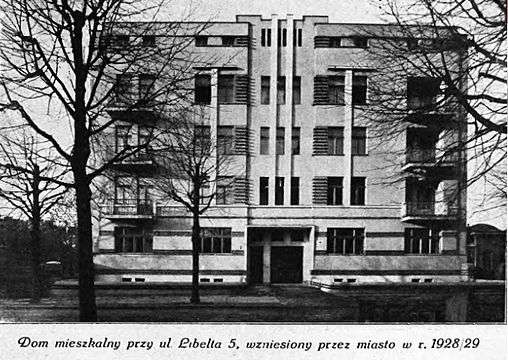 The tenement in 1929
The tenement in 1929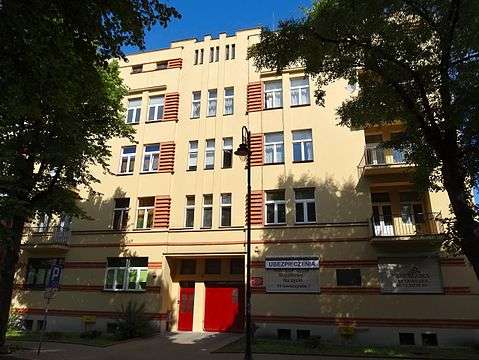 Current front view
Current front view In memoriam plaque
In memoriam plaque
Villa at 1 Asnyka street, 1932
This villa, where Bogdan Raczkowski and his family lived, is designed in the Functionalist style. The house was occupied by Nazi officials after the invasion of Poland in 1939. The neighbouring villa at 1A Asnyka -on a Bogdan's design- was built shortly before the outbreak of World War II.[3]
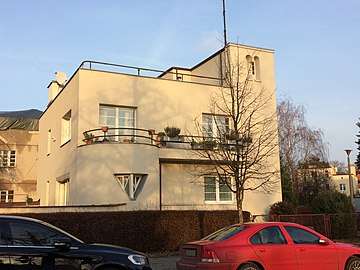 View from Kopernika Street
View from Kopernika Street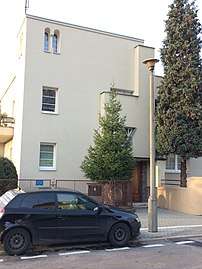 Facade onto Asnyka street
Facade onto Asnyka street
Building at 12 Poniatowskiego street, 1933
The edifice has always been used for educational purposes. It was designed by Raczkowski with engineer Kazimierz Michał Orlicz and built in 1 year, a record at a time of economic crisis,[17] to host Ewaryst Estkowski Public School. The first building stage included among others:[18]
- a basement with three rooms for manual work;
- a ground floor with manager's and teacher's room, plus 3 classrooms;
- a first floor with a doctor's office and 4 classrooms;
- a second floor with a lounge and 4 classrooms;
- a third floor comprising a drawing room and a space for scientific collections.
The outbreak of World War II prevented the implementation of the 2nd stage of building expansion, which caused to realize two separate facilities one for girls and one for boys.[19] After a thorough refurbishing in 2014, the building houses today the Institute of Political Sciences of Bydgoszcz University.
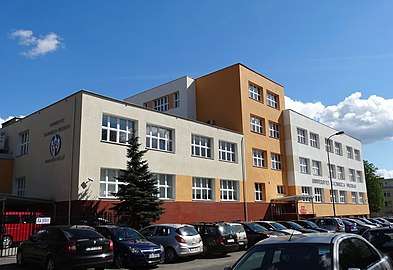 View from Poniatowskiego street
View from Poniatowskiego street One of the facade onto Poniatowskiego street
One of the facade onto Poniatowskiego street
Antoni Jurasz university hospital, 9 Marii Curie-Skłodowskiej street, 1938
The work began in July 1928, after a blessing of the foundation stone. Raczkowski, together with his colleague Kazimierz Skiciński, contracted engineer Antoni Jaworski to carry out the building. The construction was stopped during winter 1928–1929, then it slowed down and came almost to a stop in 1930, due to city financial problems. Finally, on December 13, 1937, only the west wing and the central part were officially opened.[20] It was the largest hospital built in the interwar period in Poland, with 600 beds, gathering almost all departments under the same roof at a time when pavilions structure organization was more popular in hospital construction.[3]
After Nazi invasion, the facility served as a military field hospital until August 1940. After this date, it became a civilian structure, Dr. Staemmler Krankenhaus hospital, staffed by German practitioners from Gdańsk. The entire hospital project was completed during German occupation.
 Main entry
Main entry- One of the historical buildings
See also
| Wikimedia Commons has media related to Bogdan Raczkowski. |
References
- Jastrzębski, Włodzimierz (1987). Tragedia rodziny Raczkowskich. Kalendarz Bydgoszki. Bydgoszcz: Towarzystwo Miłośników Miasta Bydgoszczy. pp. 70–73.
- Błażejewski, Stanisław, Kutta Janusz, Romaniuk Marek (1997). Bydgoski Słownik Biograficzny. Tom IV (in Polish). Bydgoszcz: Kujawsko-Pomorskie Towarzystwo Kulturalne. pp. 84–86. ISBN 83-85327-42-8.
- Wysocka, Agnieszka (2004). Bogdan Raczkowski - architekt i urbanista międzywojennej Bydgoszczy. Kronika Bydgoska 26 (in Polish). Bydgoszcz: Towarzystwo Miłosnikow Miasta Bydgoszczy - Bydgoskie Towarzystwo Naukowe. pp. 465–485.
- The International Committee of the Red Cross did not allow the use of its name for Poland since as the country did not officially exist
- S. Nowakowski, K. Fiedler. Polska Bydgoszcz. 1920-1930. Bydgoszcz: Wydanie jubileuszowe Komitetu Obchodów-Olecia oswobodzenia miasta Bydgoszczy. p. 61.
- Delineated by Ossoliński Alley, Adam Mickiewicz Alley and Markwarta, Paderewskiego and Staszica streets
- Derkowska-Kostkowska, Bogna (1999). O założeniu Sielanki-bydgoskiego miasta-ogrodu. Bydgoszcz: Materiały do dziejów kultury i sztuki Bydgoszczy i regionu. Tom 4. pp. 72–85.
- POWIATOWY PROGRAM OPIEKI NAD ZABYTKAMI POWIATU BYDGOSKIEGO NA LATA 2013-2016. Bydgoszcz: Kujawsko-pomorskie. 1 March 2014.
- Parucka, Krystyna (2008). Zabytki Bydgoszczy – minikatalog. Bydgoszcz: Tifen.
- wk (19 June 1927). Budowa domu dła starców w Bydgoszczy. Bydgoszcz: Dziennik Bydgoski. Nr 138. p. 10.
- Boguszyński, Mieczysław (2008). Od warsztatu balwierskiego do szpitala klinicznego. Bydgoszcz: Towarzystwo Miłośników Miasta Bydgoszczy. ISBN 978-83-926423-0-5.
- mc (4 November 2017). "Wypiękniał budynek sądu przy ul. Grudziądzkiej". bydgoszcz.wyborcza.pl. bydgoszcz.wyborcza. Retrieved 25 March 2020.
- Jastrzębski, Włodzimierz (2011). Encyklopedia Bydgoszczy, t. 1. Bydgoszcz: Towarzystwo Miłośników Miasta Bydgoszczy. p. 266. ISBN 978-83-926423-3-6.
- bor (27 September 2016). "Stadion Polonii znowu z nazwą. Patronem: Józef Piłsudski". bydgoszcz.wyborcza.pl. bydgoszcz.wyborcza. Retrieved 25 March 2020.
- bj (29 September 2015). "Jest moda na modernizm. Oto bydgoskie budynki w tym stylu". bydgoszcz.wyborcza.pl. bydgoszcz.wyborcza. Retrieved 21 December 2018.
- "Izba Pamięci A. G. Siedleckiego – Pracownia Teatrologiczna". biblioteka.bydgoszcz.pl. biblioteka.bydgoszcz. 2016. Retrieved 6 November 2016.
- jk (20 January 2014). "Wzorowa szkoła stanęła na Bielawach". bydgoszcz.wyborcza.pl. bydgoszcz.wyborcza. Retrieved 25 March 2020.
- Poświecenie nowej szkoły na Bielawkach. Bydgoszcz: Dziennik Bydgoski. Nr 22. 27 January 1933. p. 8.
- Perlińska, Anna (2003). Szkoła z ciemno czerwonymi pulpitami. Wspomnienie na 70-lecie Wszechnicy na Bielawkach. Kronika Bydgoska 24 (in Polish). Bydgoszcz: Towarzystwo Miłosnikow Miasta Bydgoszczy-Bydgoskie Towarzystwo Naukowe. pp. 369–375.
- "Historia Szpitala". jurasza.umk.pl (in Polish). jurasza.pl. 2015. Retrieved 25 March 2020.
Bibliography
- Wysocka, Agnieszka (2004). Bogdan Raczkowski - architekt i urbanista międzywojennej Bydgoszczy. Kronika Bydgoska 26 (in Polish). Bydgoszcz: Towarzystwo Miłosnikow Miasta Bydgoszczy - Bydgoskie Towarzystwo Naukowe. pp. 465–485.
- Błażejewski, Stanisław, Kutta Janusz, Romaniuk Marek (1997). Bydgoski Słownik Biograficzny. Tom IV (in Polish). Bydgoszcz: Kujawsko-Pomorskie Towarzystwo Kulturalne. pp. 84–86. ISBN 83-85327-42-8.